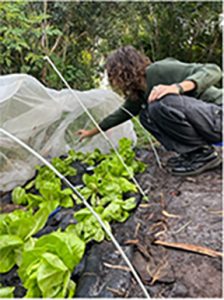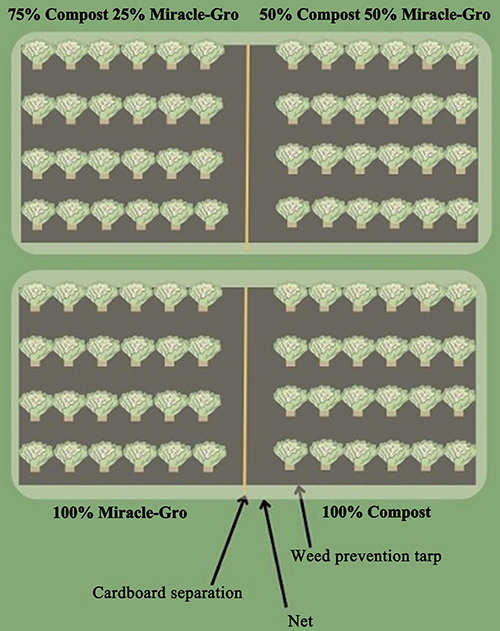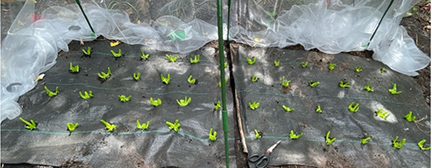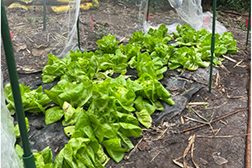Bulletin #1034, Lettuce Growth in Compost Versus Conventional Soil Systems
By Dr. Ankit Kumar Singh, Assistant Extension Professor, Maine Sustainable Agriculture and Ornamental Horticulture Educator, University of Maine Cooperative Extension and Sofia Huber, Florida Gulf Coast University.
Reviewed by Rebecca Long, Extension Professional, and Nicholas Rowley, Extension Professional, University of Maine Cooperative Extension.
For information about UMaine Extension programs and resources, visit extension.umaine.edu.
Find more of our publications and books at extension.umaine.edu/publications/.

Conventional farming is a significant source of negative environmental effects across the globe, and specifically in the United States. Conventional farming practices emit between 21-37% of global anthropogenic greenhouse gas emissions [1]. Conventional practices may cause soil desertification and salinization, spread of farm pests, climate change-induced droughts, and both air and water pollution [2]. It is estimated by the Food and Agricultural Organization (FAO) that 33% of global farmland is classified as degraded [3].
An alternative, regenerative agriculture contains several farming techniques to make food production more sustainable, including the usage of compost. Compost is the end product of a controlled decomposition process facilitated by microbial activity and can be made of any organic waste products such as yard wastes, animal manure, food waste, or, in some cases, biosolids. In previous studies, utilizing compost in farms has been shown to improve crop growth, increase soil nitrogen and water content, improve microbial biomass by altering soil chemical properties, and protect soils and crops from high heat and droughts [4][5][6][7]. The goal of our study was to compare the impact of growing ‘Rex’ Butterhead Lettuce Lactuca sativa in different ratios of compost and Miracle-Gro soil.
Materials and Methods
This experiment was conducted at Florida Gulf Coast University (FGCU) during the winter of 2023, and were not replicated. The growing cycle was designed to simulate Maine’s summer conditions, matching both daylight time and temperature. The plugs were grown indoors in a grow tent for 15 days and then transplanted into four plots in the FGCU Food Forest (FGCU-FF). Rock-wool and coconut coir plug mediums were used to grow the plugs saturated with Reverse Osmosis (RO) water. They were covered in newspaper and placed in the dark grow tent for 48 h. After, the LED lights were turned on for the first 15 days. During this 15-day period, the plugs were given a starter solution of fertilizer each day. Once transferred to the FGCU-FF, 200 mL of water was added to each lettuce plug every morning for 60 days before sunrise.
The four treatments included varying ratios of Blue Ribbon Organics Organic Compost and Miracle-Gro Potting Soil (100% Compost, 100% Miracle-Gro, 75% Compost and 25% Miracle-Gro, and 50% Compost and 50% Miracle-Gro). Miracle-Gro potting soil was used to represent the most general soil conditions at conventional farms. The Blue Ribbon compost was a plant organic fertilizer, as it was made of food and yard waste. We wanted to use soil that was representative of most growing conditions and could be applicable anywhere, not varying by different geology of regions. The existing soil was dug out and manually removed to be entirely replaced with the four mixtures.
The Leafscan app was downloaded to calculate the total leaf area (LA) [8]. To collect wet weight, each lettuce plant was washed and the roots were removed. A chlorophyll meter was used to calculate each sample’s overall chlorophyll and nitrogen content. To obtain dry weight after collecting all other data, the crops were placed in brown paper bags to be left in a drying oven.

Results
On the 60th day of growth in the FGCU-FF, all the lettuce crops were harvested from all four plots. The median values for wet weight, dry weight, LA, nitrogen, are presented in Table 1, along with the mean values of chlorophyll, and the standard deviations for each. The standard deviations show how large of a difference there is between the average plant and the largest/smallest plant.
The heaviest lettuce crops, regarding wet weight, were produced by the 100%C soil treatment. The smallest wet weight was produced by the 50%C-50%MG soil mixture. Overall, there was a large variation in wet weight for all four treatments. While the soil treatments of 100%C and 100%MG produced the heaviest lettuce crops, they also produced the most variable harvests.

Regarding dry weight, the heaviest crops were produced by the 100%-MG soil treatment. Comparative to the wet weight results, the 100%MG yielded the largest crops. However, the 100%C soil showed the greatest variability in mass. The variability in compost composition can lead to fluctuations in crop weight, as inconsistent nutrient distribution may affect plant growth and yield unpredictably.
The 100%C soil treatment produced the crops with the overall highest leaf areas. Lettuce crops with 100%MG soil yielded the highest nitrogen content. The medians, again, do not show a large difference in the nitrogen readings for each soil treatment.
Based on statistical analysis, soil medium was found to be important. It significantly impacted wet weight, dry weight, and leaf area, but not nitrogen. 100%C and 100%MG had the same effect on wet weight, dry weight, and LA. However, they both produced significantly greater wet weights, dry weights, and leaf areas compared to the 75%C-25%MG and 50%C-50%MG compositions.
Table 1: Median wet weights, dry weights, LA, nitrogen, and the mean chlorophyll. Standard deviations are recorded to the right in parentheses.
| 100% Compost | 75% Compost, 25% Miracle-Gro | 50% Compost, 50% Miracle-Gro | 100% Miracle-Gro | |
|---|---|---|---|---|
| Wet Weight (g) | 79.24 (50.99) | 35.48 (32.47) | 34.14 (31.77) | 72.36 (30.65) |
| Dry Weight (g) | 3.11 (1.65) | 1.77 (1.59) | 1.59 (0.89) | 3.57 (0.95) |
| LA (cm2) | 1289.58 (644.16) | 764.58 (727.8) | 704.12 (422.99) | 1187.84 (398.57) |
| Nitrogen (mg/g) | 9.67 (0.58) | 9.43 (0.39) | 9.67 (1) | 9.75 (0.95) |
| Chlorophyll (mg/cm2) | 0.0161 | 0.0144 | 0.0150 | 0.0149 |
Conclusions
In conclusion, the 100%C and 100% MG soil treatments produced the most successful lettuce crops. The 100%C soil treatment yielded lettuce crops with the heaviest wet weights and the largest LAs, and the 100% MG soil treatment yielded the heaviest dry weights and the highest nitrogen readings. It is important to note that the two mixture plots (75%C-25%MG and 50%C-50%MG) faced an infestation of armyworm caterpillars, which may have potentially altered some results.
It is not unexpected for the 100%C and 100%MG soil treatments to produce data results so closely related, as the research previously mentioned demonstrates that compost benefits overall crop growth, and conventional soils, such as Miracle-Gro, promote crop growth. Miracle-Gro and other conventional medias are used on such a large scale because they allow farmers to produce bountiful crops for a period, however, the soil eventually becomes degraded and cannot be used any longer. Due to the 100%C treatment yielding crops of overall similar success to the 100%MG soil treatment, the conclusion may be drawn based on these experiments that compost-based soil systems could compete directly with conventional soils. If farmers desire their lettuce crops to have larger wet weights, LAs, and chlorophyll content, it would be suggested to utilize compost. However, if the farmers desire heavier dry weights and higher nitrogen content, it would be suggested to utilize Miracle-Gro.
Figure 4: Progression of growth in 100% Compost plot (left) and 100% Miracle-Gro (right).
Figure 2 interpretation
Figure 2 depicts a diagram of the experimental set-up in the Food Forest at FGCU. There are two plots, each further divided into two sub-plots, separated by cardboard. The plots have a pest prevention net surrounding them, as well as a weed prevention tarp. Each sub-plot has 24 lettuce plants. The top left sub-plot is the 75% Compost, 25% Miracle-Gro treatment. The top right sub-plot is the 50% Compost, 50% Miracle-Gro treatment. The bottom left sub-plot is the 100% Miracle-Gro treatment. The bottom right sub-plot is the 100% Compost treatment.
References
- IPCC (2019). Summary for policymakers. In P. R. Shukla, J. Skea, E. C. Buendia, V. Mas-son Delmotte, H.-O. Pörtner, D. C. Roberts, P. Zhai, R. Slade, S. Connors, R. van Diemen, M. Ferrat, E. Haughey, S. Luz, S. Neogi, M. Pathak, J. Petzold, J. P. Pereira, P. Vyas, E. Huntley, et al. (Eds.), Climate change and land: An IPCC special report on climate change, desertification, land degradation, sustainable land management, food security, and greenhouse gas fluxes in terrestrial ecosystems. IPCC. ipcc.ch/site/assets/uploads/sites/4/2022/11/SRCCL_SPM.pdf
- Kozai, Toyoki, Next, T., Indoor, G., & Farms, V. (2018). Smart Plant Factory. In Smart Plant Factory. doi.org/10.1007/978-981-13-1065-2
- Taghizadeh, R. (2021). Assessing the potential of hydroponic farming to reduce food imports: The case of lettuce production in Sweden.
- Chang, E., Chung, R., & Tsai, Y. (2007) Effect of different application rates of organic fertilizer on soil enzyme activity and microbial population, Soil Science and Plant Nutrition, 53:2, 132-140, DOI: 10.1111/j.1747-0765.2007.00122.x
- Tejada, M., Garcia, C., Gonzalez, J. L., & Hernandez, M. T. (2006). Use of organic amendment as a strategy for saline soil remediation: Influence on the physical, chemical and biological properties of soil. Soil Biology & Biochemistry, 38(6), 1413–1421. doi.org/10.1016/j.soilbio.2005.10.017
- Weindorf, D. C., Zartman, R. E., & Allen, B. L. (2006). Effect of Compost on Soil Properties in Dallas, Texas. Compost Science & Utilization, 14(1), 59–67. doi.org/10.1080/1065657x.2006.10702264
- Charles, D., Randall, J., Dove, R., Thompson, M., & Needham, T. (2023). Guest editorial: managing our soils: learning from the past to help feed a growing world population. The Journal of Agricultural Science, 161(1), 3-5. doi.org/10.1017/S0021859622000703
- Anderson, C.J.R. and Rosas-Anderson, P.J. (2017) Leafscan (Version 1.3.21). Mobile Application Software. itunes.apple.com/app/id1254892230
Information in this publication is provided purely for educational purposes. No responsibility is assumed for any problems associated with the use of products or services mentioned. No endorsement of products or companies is intended, nor is criticism of unnamed products or companies implied.
© 2025
Call 800.287.0274 (in Maine), or 207.581.3188, for information on publications and program offerings from University of Maine Cooperative Extension, or visit extension.umaine.edu.
In complying with the letter and spirit of applicable laws and pursuing its own goals of diversity, the University of Maine System does not discriminate on the grounds of race, color, religion, sex, sexual orientation, transgender status, gender, gender identity or expression, ethnicity, national origin, citizenship status, familial status, ancestry, age, disability physical or mental, genetic information, or veterans or military status in employment, education, and all other programs and activities. The University provides reasonable accommodations to qualified individuals with disabilities upon request. The following person has been designated to handle inquiries regarding non-discrimination policies: Director of Institutional Equity and Title IX Services, 5713 Chadbourne Hall, Room 412, University of Maine, Orono, ME 04469-5713, 207.581.1226, TTY 711 (Maine Relay System).



